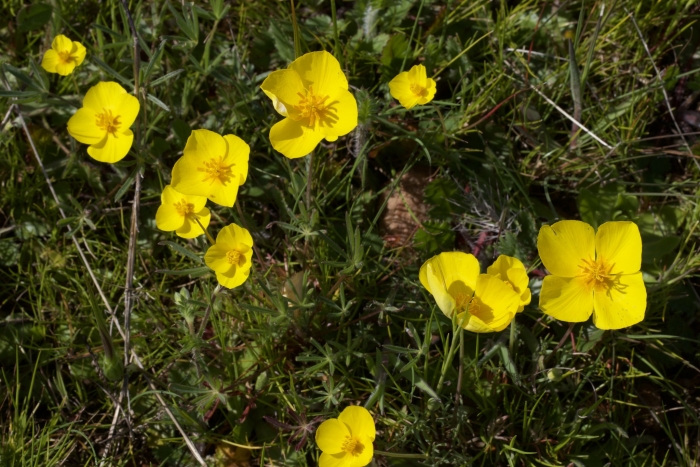Frying Pans
(Eschscholzia lobbii)
Frying Pans (Eschscholzia lobbii)
/
/

Arvel Hernandez
CC BY 4.0
Image By:
Arvel Hernandez
Recorded By:
Copyright:
CC BY 4.0
Copyright Notice:
Photo by: Arvel Hernandez | License Type: CC BY 4.0 | License URL: http://creativecommons.org/licenses/by/4.0/ | Rights Holder: Arvel Hernandez | Publisher: iNaturalist | Date Created: 2023-03-24T14:16:35-07:00 |

























Estimated Native Range
Summary
Eschscholzia lobbii, commonly known as Frying Pans, is an annual herb endemic to California, specifically the Central Valley and the adjacent Sierra Nevada foothills. It is typically found in grasslands and open areas, often near vernal pools, which are temporary pools of water that provide habitat for distinctive plants and animals. This species is part of the diverse California Floristic Province, a biodiversity hotspot. Frying Pans grows from a basal rosette of segmented leaves with pointed leaflets and produces erect stalks up to 6 inches tall. Each stalk bears a single bright yellow to somewhat orange poppy flower about a centimeter long, blooming from late winter to early spring. The fruit is a slender capsule 1-3 inches long containing tiny brown seeds.
Frying Pans is valued for its vibrant flowers that add a splash of color to wildflower gardens and meadow plantings. It is relatively low maintenance, requiring minimal water once established, and thrives in well-drained soils with full sun exposure. While not commonly used in formal garden settings, it can be an attractive addition to native plant gardens and restoration projects. Its drought tolerance makes it suitable for xeriscaping. However, it is not a long-lived plant and may need to be reseeded annually to maintain a presence in the garden.CC BY-SA 4.0
Frying Pans is valued for its vibrant flowers that add a splash of color to wildflower gardens and meadow plantings. It is relatively low maintenance, requiring minimal water once established, and thrives in well-drained soils with full sun exposure. While not commonly used in formal garden settings, it can be an attractive addition to native plant gardens and restoration projects. Its drought tolerance makes it suitable for xeriscaping. However, it is not a long-lived plant and may need to be reseeded annually to maintain a presence in the garden.CC BY-SA 4.0
Plant Description
- Plant Type: Herb
- Height: 0.5-1 feet
- Width: 0.5-1 feet
- Growth Rate: Moderate
- Flower Color: Yellow
- Flowering Season: Spring, Summer
- Leaf Retention: Deciduous
Growth Requirements
- Sun: Full Sun
- Water: Low, Medium
- Drainage: Medium
Common Uses
Border Plant, Drought Tolerant, Low Maintenance, Rock Garden
Natural Habitat
Native to grasslands and open areas, often near vernal pools, in California’s Central Valley and the adjacent Sierra Nevada foothills
Other Names
Common Names: Chilean Poppy
Scientific Names: , Eschscholzia lobbii, Eschscholzia graminea, Eschscholzia pulchella, Eschscholzia unguiculata,
GBIF Accepted Name: